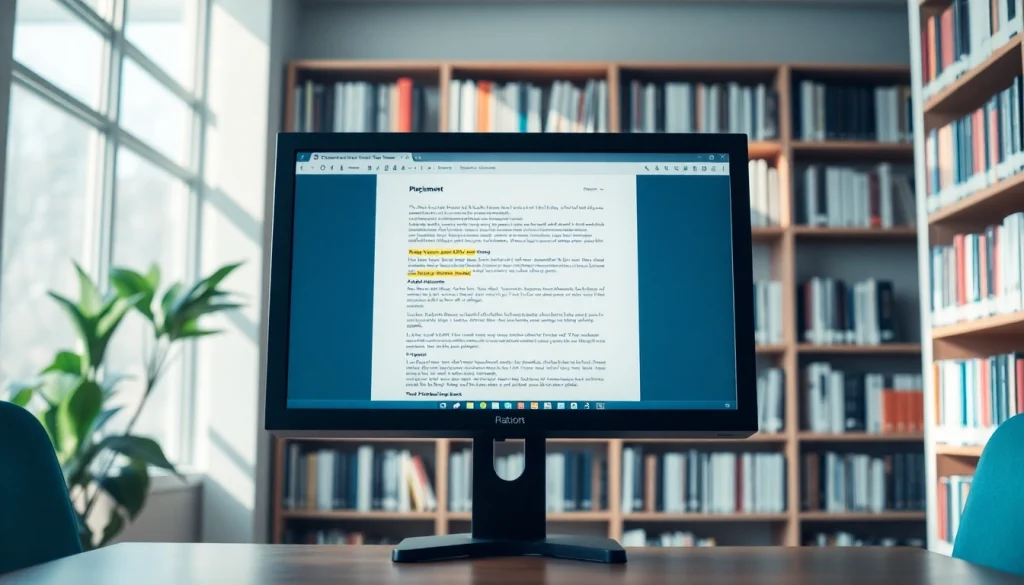Understanding the Importance of a Plagiarism Checker
In today’s digital age, the significance of originality in academic and professional writing cannot be overstated. A plagiarism checker plays a crucial role in ensuring that the content produced is not only genuine but also free from any unintended similarities with existing works. Whether you are a student, educator, researcher, or professional writer, utilizing a plagiarism checker is essential in maintaining integrity and upholding ethical standards within your field.
Why Plagiarism Matters in Academia
Plagiarism is defined as the unauthorized use or representation of someone else’s work or ideas as one’s own. In academia, this issue is particularly sensitive. It not only undermines the educational process but also jeopardizes the credibility of institutions and the validity of qualifications awarded. Plagiarism can result in severe consequences, ranging from failing grades to expulsion in educational settings, and even legal ramifications in professional contexts.
Moreover, the integrity of research is built on originality and acknowledgment of sources. Plagiarism can distort the academic record, misrepresent the contributions made by researchers and scholars, and ultimately lead to a lack of trust in published work. Institutions are increasingly reliant on advanced tools and services to combat this growing concern.
The Role of Originality in Academic Success
Originality in academic work not only attests to an individual’s understanding of their subject matter but also reflects their critical thinking and analytical skills. Producing original content encourages students and researchers to engage with their material thoughtfully. It fosters creativity, innovation, and unique perspectives, essential aspects that guide scholarly debate and advancement in various fields.
Furthermore, students who develop strong original work prepare themselves for future professional success. Employers seek candidates who can think independently, develop original ideas, and contribute uniquely to their organizations. The implication of scholarship extends far beyond grades and certificates; it lays the foundation for future growth and achievement.
Common Myths about Plagiarism
Despite the critical nature of plagiarism, various myths linger, contributing to misunderstandings about its implications. One prevalent myth is that plagiarism only pertains to direct copying of text. In reality, it includes paraphrasing without proper attribution, presenting someone else’s ideas without credit, and even self-plagiarism, where one’s previous work is re-used without acknowledgment. Understanding these nuances is essential for any author or creator.
Another myth suggests that plagiarism checkers eliminate the possibility of committing plagiarism. While these tools do provide significant assistance, they are not foolproof. It is still necessary for individuals to comprehend the principles of citation, originality, and ethical writing.
How a Plagiarism Checker Works
Analyzing Text for Similarities
A plagiarism checker operates by comparing the submitted content against a vast database of sources, including academic journals, articles, books, and websites. The software employs sophisticated algorithms to detect text similarities, matching phrases and sentences to previously published works. High-quality plagiarism checkers utilize advanced linguistic analysis techniques to identify rephrased content as well, ensuring a thorough examination of originality.
Using Algorithms for Detection
The core technology behind plagiarism detection relies on complex algorithms designed to analyze the structure, syntax, and semantics of text. These algorithms assess both direct matches and potential paraphrasing, leveraging AI and machine learning to improve detection accuracy over time. As a result, these tools can provide comprehensive reports detailing any instances of similarity, allowing authors to address issues of concern before publication.
Understanding the Output Reports
After the analysis, plagiarism checkers generate detailed reports that outline the detected similarities, percentage of originality, and the sources matched. Understanding these reports is pivotal for users, as they highlight not just where the content may overlap with existing works but also guide users in correcting citations or restructuring sentences to ensure authenticity. Many checkers also provide suggestions for rewording, thus aiding the revision process.
Choosing the Right Plagiarism Checker
Features to Look for in a Plagiarism Checker
Selecting an appropriate plagiarism checker requires careful consideration of various features. Look for tools that boast a comprehensive database for comparison, including academic journals, public websites, and proprietary content. Additional features to consider include:
- Real-time analysis: Ability to check content as it is being written, promoting immediate feedback.
- User-friendly interface: Easy navigation enhances user experience, especially for those who may not be tech-savvy.
- Various file format support: Ensure the tool can analyze different formats such as DOCX, PDF, and more.
- API support: For developers, having an API feature can be essential for integrating plagiarism checking into other applications.
- Performance metrics: Detailed analytics inform users about their writing patterns over time.
Comparing Free vs. Paid Options
While several free plagiarism checkers exist, they may lack the depth and comprehensiveness of their paid counterparts. Free versions might provide basic analysis, but often have limitations on word count or provide less thorough reports. Paid options, in contrast, typically offer advanced features, better user support, and a larger database for comparison. Weighing the costs against the potential benefits is essential when deciding on a plagiarism checker suited to your needs.
Reading User Reviews and Ratings
Before selecting a plagiarism checker, researching user reviews and ratings can provide insight into the tool’s effectiveness and user satisfaction. Feedback from peers can reveal potential issues or strengths that may not be apparent through marketing materials. Platforms where users frequently discuss their experiences can be especially helpful in making informed choices about the appropriate tool for your needs.
Best Practices for Avoiding Plagiarism
Citing Sources Correctly
Proper citation is paramount in maintaining credibility and avoiding plagiarism. Familiarizing oneself with various citation styles—is crucial as they may differ by discipline. Common styles include APA, MLA, and Chicago. Each style has specific guidelines for how to format sources and in-text citations, strengthen the author’s argument, and contribute to the scholarly conversation.
Paraphrasing vs. Quoting
Understanding when to paraphrase and when to quote directly is essential for writing original content. Paraphrasing involves rephrasing someone else’s ideas in your own words, while quoting entails using the exact words from a source, surrounded by quotation marks. Both require proper attribution to acknowledge the original author. Being adept at utilizing these strategies can help prevent unintentional plagiarism while enriching your writing.
Utilizing Writing Assistance Tools
In addition to plagiarism checkers, numerous writing assistance tools can enhance the quality of your writing. Grammar and style checkers, thesauruses, and readability analyzers are helpful resources for refining your writing. Employing these tools can improve the clarity and flow of your content, contributing to a stronger, more engaging narrative.
Future Technologies in Plagiarism Detection
The Evolution of AI in Writing
Advancements in artificial intelligence have significantly impacted plagiarism detection, enhancing the accuracy and speed of analysis. Machine learning algorithms are now capable of learning from user behavior, developing more sophisticated detection methods as they encounter new writing styles and trends. Consequently, this evolution has made detecting even updated forms of plagiarism increasingly precise.
Emerging Trends in Plagiarism Checking
Looking ahead, several trends are likely to shape the future of plagiarism detection. Real-time checking features, integrations with educational platforms, and adaptive learning components are expected to become standard offerings. As the nature of academic writing evolves, plagiarism checkers will need to adapt accordingly, offering tools that cater specifically to shifting practices and technologies.
Enhancing User Experience with Technology
Emerging technologies will likely place increasing importance on user experience. Enhanced interfaces, intuitive navigation, and personalized results are anticipated improvements in the user journey with plagiarism checkers. By focusing on user experience, developers can ensure that these tools are not only effective but accessible and beneficial to a broader audience.


